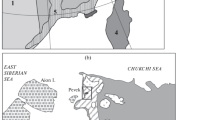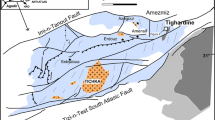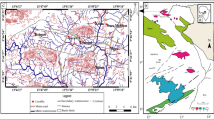Abstract
Geological and geochemical characteristics of the litho units exposed in and around Kalalikhera area of Pur-Banera belt have confirmed the presence of felsic volcanic rock unit named Kalalikhera felsic volcanic, with characteristic features such as (i) abundance of lapilli composed of polygonal quartz and feldspar and (ii) presence of relict bipyramidal quartz. These volcanics are associated with thin bands of chert. Geochemically, the volcanics are found to be of rhyolitic composition. Development of garnet porphyroblasts along with preferred orientation of the silicate minerals of rhyolite indicates a low to medium grade metamorphism and deformation of the units. Monazite geochemistry of the volcanics indicated towards the metamorphic origin of monazites, with REE pattern show steep fractionation trend from La to Lu. The in-situ chemical age of 2192 ± 57 Ma recorded from xenotime is interpreted as indicative of the opening of the Aravalli basin with the onset of rifting leading to the formation of Kalalikhera volcanics. The estimated ages of 1784 ± 92, 1351 ± 45 and 1026 ± 57 Ma from monazite analyses are interpreted as different metamorphic events associated with (i) closure of the basin and the onset of Aravalli orogeny, (ii) further imprints of Delhi orogeny, and (iii) with late Grenvillian age imprints.











Similar content being viewed by others
References
Ahmad T and Tarney J 1991 Geochemistry and petrogenesis of Garhwal volcanics: Implications for evolution of the north Indian lithosphere; Precamb. Res. 50 69–88.
Ahmad T, Dragusanu C and Tanaka T 2008a Provenance of Proterozoic Basal Aravalli mafic volcanics rocks from Rajasthan, northwestern India: Nd isotopes evidence for enriched mantle reservoirs; Precamb. Res. 162 150–159.
Ahmad T, Tanaka T, Sachan H K, Asahara Y, Islam R and Khanna P P 2008b Geochemical and isotopic constraints on the age and origin of the Nidar Ophiolitic Complex, Ladakh, India: Implications for the Neo-Tethyan subduction along the Indus suture zone; Tectonophysics 451 206–224.
Andrehs G and Heinrich W 1998 Experimental determination of REE distributions between monazite and xenotime: Potential for temperature-calibrated geochronology; Chem. Geol. 149 83.
Berger A, Gnos E, Janots E, Fernandez A and Giese J 2008 Formation and composition of rhabdophane, bastnäsite and hydrated thorium minerals during alteration: Implications for geochronology and low-temperature processes; Chem. Geol. 254 238–248.
Buck H M, Cooper M A, Cěrný P, Grice J D and Hawthorne F C 1999 Xenotime-(Yb), YbPO4, a new mineral species from the Shatford Lake pegmatite group, southeastern Manitoba, Canada; Can. Mineral. 37 1303–1306.
Chen W, Honghui H, Bai T and Jiang S 2017 Geochemistry of monazite within carbonatite related REE deposits; Resources 6 51.
Condie K C 1994 Greenstones through Time; In: Archean Crustal Evolution (ed.) Condie K C, Elsevier, Amsterdam.
Condie K C 2000 Episodic continental growth models: Afterthoughts and extension; Tectonophysics 322 153–162.
Crawford A R 1970 The Precambrian geochronology of Rajasthan and Bundelkhand, Northern India; Canadian J. Earth Sci. 125 91–110.
Deb M, Thorpe R I, Cumming G L and Wagner P A 1989 Age source and stratigraphic implications of Pb isotope data for conformable, sediment-hosted, base metal deposits in the Proterozoic Aravalli–Delhi orogenic belt, northwestern India; Precamb. Res. 43 1–22.
D’Souza J, Prabhakar N, Yigang Xu, Sharma K K and Sheth H 2019 Mesoarchaean to Neoproterozoic (3.2–0.8 Ga) crustal growth and reworking in the Aravalli Craton, northwestern India: Insights from the Pur-Banera supracrustal belt; Precamb. Res. 332 105383, https://doi.org/10.1016/j.precamres.2019.105383.
Förster H J 1998a The chemical composition of REE–Y–Th–U-rich accessory minerals in peraluminous granites of the Erzgebirge–Fichtelgebirge region, Germany; Part I: The monazite-(Ce)-brabantite solid solution series; Am. Mineral. 83 259–272.
Förster H J 1998b The chemical composition of REE–Y–Th–U-rich accessory minerals in peraluminous granites of the Erzgebirge–Fichtelgebirge region, Germany; Part II: Xenotime; Am. Mineral. 83 1302–1315.
Gopalan K, Macdougall J D, Roy A B and Murali A B 1990 Sm–Nd evidence for 3.3 Ga old rocks in Rajasthan, northwestern India; Precamb. Res. 48 287–297.
Gupta B C 1934 The geology of central Mewar; Geol. Soc. India Memoir 65 107–168.
Gupta S N, Arora Y K, Mathur R K, Iqballuddin, Prasad B, Sahai T N and Sharma S B 1980 Lithostratigraphic map of Aravalli region; Geol. Surv. of India, Calcutta, Scale 1:1,000,000.
Hazarika P, Upadhyay D and Mishra B 2013 Contrasting geochronological evolution of the Rajpura–Dariba and Rampura–Agucha metamorphosed Zn–Pb deposit, Aravalli–Delhi Belt, India; J. Asian Earth Sci. 73 329–339.
Heron A M 1953 Geology of Central Rajasthan; Geol. Surv. India Memoir Kolkata 79 339.
Imai N, Terashima S, Itoh S and Ando A 1995 Compilation of analytical data for minor and trace elements in seventeen GSJ geochemical reference samples, ‘Igneous rock series’; Geostand. Newslett. 19 135–213.
Kerr A C, White R V and Saunders A D 2000 LIP Reading: Recognizing Oceanic Plateaux in the geological record; J. Petrol. 41 1041–1056.
Ludwig K R 2003 Isoplot 3.00: A geochronological toolkit for Microsoft Excel, Berkeley Geochronology Center, Berkeley, 70p.
Mclennan S M 1994 Rare earth element geochemistry and the ‘tetrad’ effect; Geochim. Cosmochim. Acta 58(9) 2025–2033.
Ozha M K, Mishra B, Hazarika P, Jeyagopal A V and Yadav G S 2016 EPMA monazite geochronology of the basement and supracrustal rocks within the Pur-Banera basin, Rajasthan: Evidence of Columbia breakup in northwestern India; J. Asian Earth Sci. 117 284–303.
Ondrejka M, Uher P, Pršek J and Daniel O 2007 Arsenian monazite-(Ce) and xenotime-(Y), REE arsenates and carbonates from the Tisovec–Rejkovo rhyolite, Western Carpathians, Slovakia: Composition and substitutions in the (REE, Y) XO4 system (X = P, As, Si, Nb, S); Lithos 95 116–129.
Pearce J A, Harris N B and Tindle A G 1984 Trace element discrimination diagrams for the tectonic interpretation of granitic rocks; J. Petrol. 25 956–983.
Quach D-T and Hans K 2015 Monazite and xenotime solubility in granitic melts and the origin of the lanthanide tetrad effect; Contrib. Mineral. Petrol. 169 8.
Sastry C A 1992 Geochronology of the Precambrian rocks from Rajasthan and northeastern Gujarat; Geol. Surv. India Spec. Publ. 5 1–41.
Schandl E and Gorton M 2004 A textural and geochemical guide to the identification of hydrothermal monazite: Criteria for selection of samples for dating epigenetic hydrothermal ore deposits; Econ. Geol. 99 1027–1035. https://doi.org/10.2113/99.5.1027.
Seydoux-Guillaume A M, Wirth R, Nasdala L, Gottschalk M, Montel J M and Heinrich W 2002 An XRD, TEM and Raman study of experimentally annealed natural monazite; Phys. Chem. Mineral. 29 240–253.
Singh A K and Singh R K B 2012 Petrogenetic evolution of the felsic and mafic volcanics suite in the Siang window of Eastern Himalaya, North East India; Geosci. Front. 3(5) 613–634.
Sinha-Roy S 1989 Strike-slip fault and pull apart basins in Proterozoic fold belt developed in Rajasthan; Ind. Mineral 43(3&4) 226–240.
Spear F S and Pyle J M 2002 Apatite, monazite, and xenotime in metamorphic rocks; Rev. Mineral. Geochem. 48 293–335.
Sun S S and McDonough W F 1989 Chemical and isotopic systematics of ocean basalts: Implications for mantle composition and processes, in Magmatism in the Ocean Basins, December 1989; Geol. Soc. London, Spec. Publ. 423 13–345.
Suzuki K and Adachi M 1991 Precambrian provenance and Silurian metamorphism of the Tsubonosawa paragneiss in the South Kitakami terrane, Northeast Japan, revealed by the chemical Th–U–total Pb isochron ages of monazite, zircon, and xenotime; Geochem. J. 25 357–376.
Uher P, Ondrejka M and Konečný P 2009 Magmatic and post-magmatic Y–REE–Th phosphate, silicate and Nb–Ta–Y–REE oxide minerals in A-type metagranite: An example from the Turčok massif, the Western Carpathians, Slovakia; Mineral. Mag. 73 1009–1025.
Ward D A and Miller C F 1993 Accessory mineral behavior during differentiation of a granite suite: Monazite, xenotime and zircon in the Sweetwater Wash pluton, southeastern California, U.S.A; Chem. Geol. 110 49–67.
Wiedenbech M, Goswami J N and Roy A B 1996 Stabilization of Aravalli Craton of northwestern India at 2.5 Ga: An ion microprobe zircon study; Chem. Geol. 129 325–340.
Yousuf I, Subba Rao D V, Balakrishnan S and Ahmad T 2019 Geochemistry and petrogenesis of acidic volcanics from Betul–Chhindwara Belt, Central Indian Tectonic Zone (CITZ), central India; J. Earth Syst. Sci., https://doi.org/10.1007/s12040-019-1255-x.
Zhu X K, O’Nions R K, Zhu X and O’Nions R 1999 Monazite chemical composition: Some implications for monazite geochronology; Contrib. Mineral. Petrol. 137 351–363.
Acknowledgements
The authors are thankful to the Additional Director General, Geological Survey of India, Western Region, Jaipur for support and encouragement. The first author is thankful to Dr P R Golani, Deputy Director General (Retd.), Geological Survey of India who inspired me to write this manuscript. The authors are thankful to Dr Ausaf Raza, Senior Geologist, and Ms Sonalika Joshi, Superintending Geologist for their technical advice. We acknowledge the officials of the Chemical Laboratory, GSI, Jaipur, and EPMA Laboratory, GSI, Hyderabad for analytical support.
Author information
Authors and Affiliations
Contributions
Suresh Chander: Conceptualisation, visualisation, methodology, field investigation collection of field data and writing of original draft. Santanu Bhattacharjee: Petrography, EPMA study with analytical methods. Manideepa Roy Choudhury: Conceptualisation and incorporation of write up with additional ideas on geochemical data interpretation. Nikhil Agarwal: Incorporation of write up with additional ideas.
Corresponding author
Additional information
Communicated by N V Chalapathi Rao
Rights and permissions
About this article
Cite this article
Chander, S., Bhattacharjee, S., Choudhury, M.R. et al. Characterisation of Kalalikhera felsic volcanics, Pur-Banera belt, Rajasthan: Insights from monazite–xenotime geochemistry and chemical ages. J Earth Syst Sci 130, 84 (2021). https://doi.org/10.1007/s12040-021-01572-8
Received:
Revised:
Accepted:
Published:
DOI: https://doi.org/10.1007/s12040-021-01572-8




